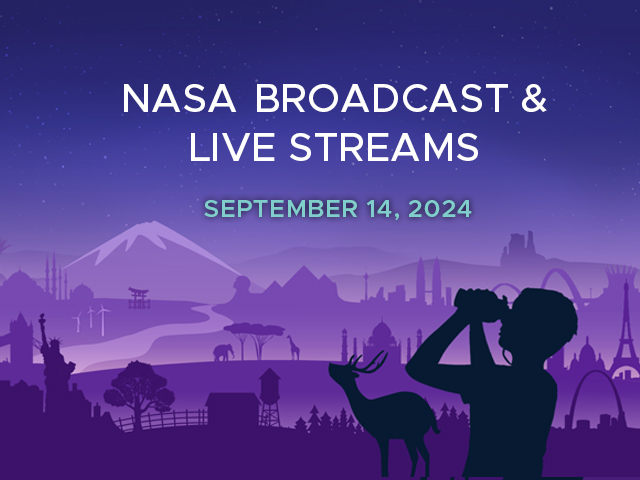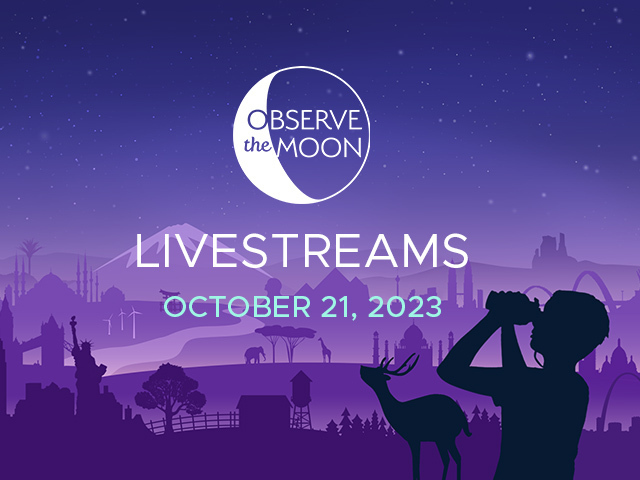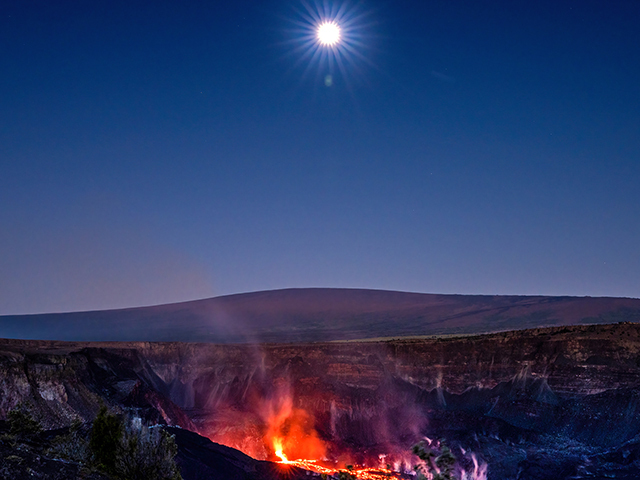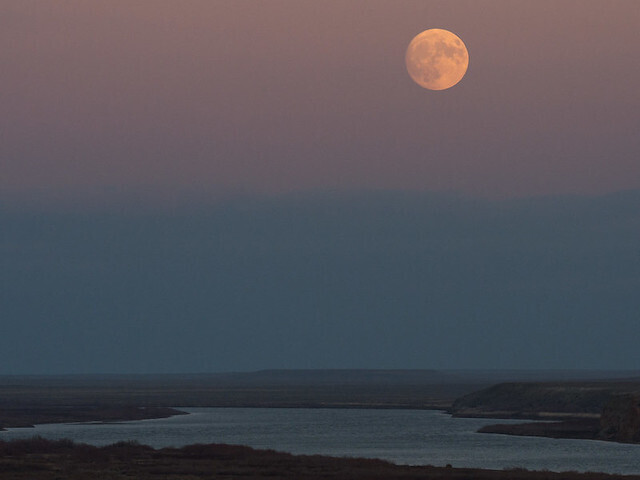News | February 5, 2017
The Snow Moon
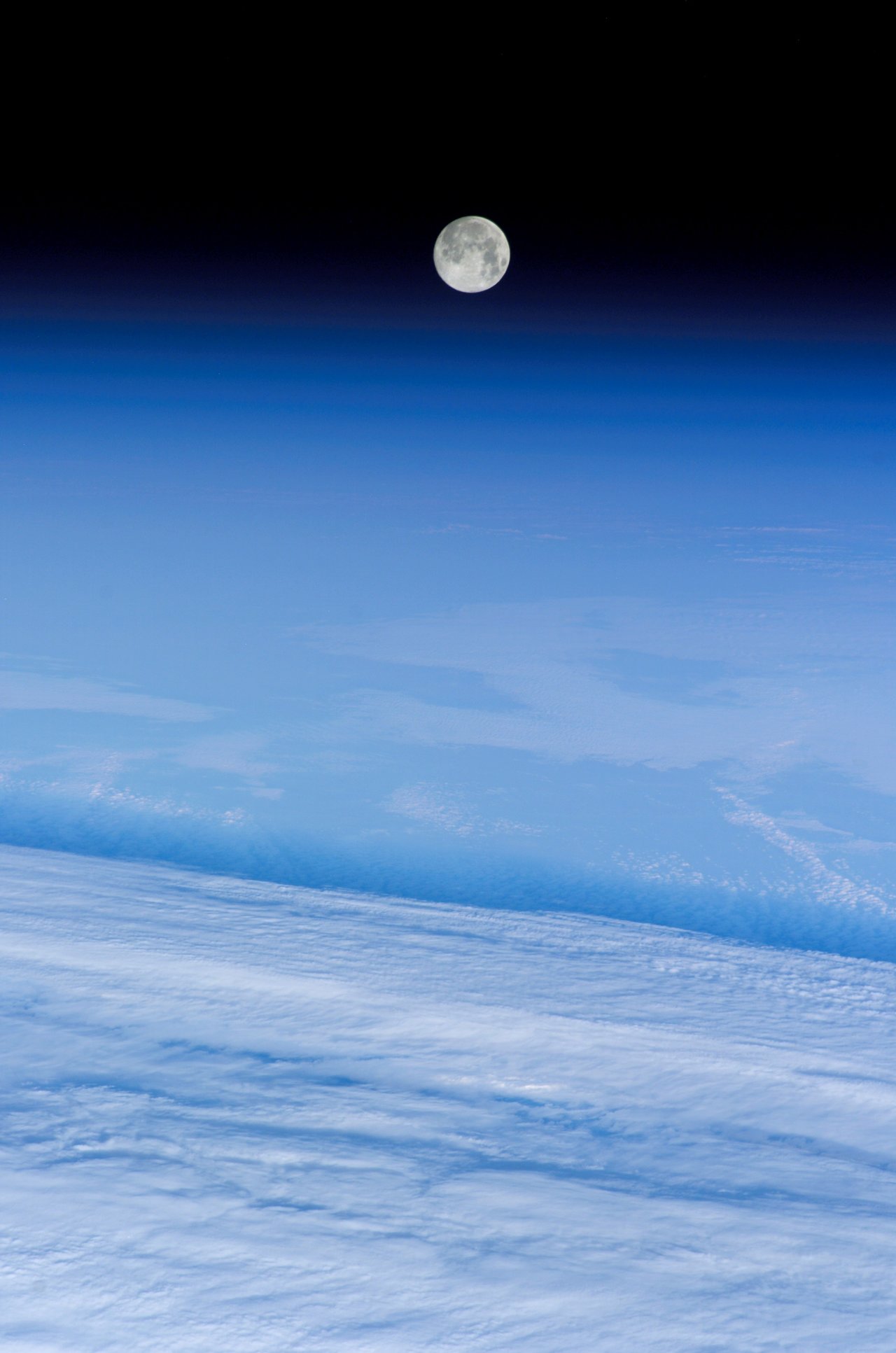
"Snow Moon" over Earth taken by the International Space Station, 02/12/06. Credit: NASA
The next full Moon will be on Friday evening, February 10, 2017, appearing "opposite" the Sun (in Earth-based longitude) at 7:33 PM EST. The Moon will appear full for about three days around the eclipse, from Thursday evening through Sunday morning. On Friday evening the full Moon will be dimmed slightly by the partial shadow of the Earth, although it will be hard to notice the difference. The bright star below and to the left of the Moon will be Regulus.
As the midwinter Moon or the second full Moon of Winter, the Native American tribes of what is now the northern and eastern United States called this the Snow Moon or the Hunger Moon. It was known as the Snow Moon because of the heavy snows that fall in this season (NOAA long-term monthly averages for the Washington, DC area show January and February nearly tied as the snowiest months of the year). Bad weather and heavy snows made hunting difficult, so this Moon was also called the Hunger Moon.
In lunisolar calendars the months change with the new Moon and full Moons fall in the middle of the lunar months. This full Moon is the middle of the first month of the Chinese calendar and Shevat in the Hebrew calendar. The 15th day of Shevat, corresponding with the Full Moon, is the holiday Tu BiShvat. Tu BiShvat begins at sunset on February 10 and ends at nightfall on February 11). Tu BiShvat is also called "Rosh HaShanah La'Ilanot" (literally "New Year of the Trees"). In contemporary Israel, the day is celebrated as an ecological awareness day, and trees are planted in celebration.
In the Islamic calendar the months start with the first sighting of the waxing crescent Moon a few days after the New Moon. This full Moon is near the middle of Jumada al-awwal, the fifth month of the calendar.
As usual, the wearing of suitably celebratory celestial attire is encouraged in honor of the full Moon.
As for other celestial events between now and the full Moon after next:
In mid-winter the daily periods of sunlight continue to lengthen. The old Celtic calendar used in much of pre-Christian Europe considered winter to be the the quarter of the year with the shortest periods of daylight and the longest periods of night, so that Winter started around Halloween and ended around Groundhog Day (February 2nd). We are now in Spring by this old calendar, but have 6 more weeks of Winter under our current calendar.
On the day of the February full Moon, morning twilight will begin at 6:06 AM, sunrise will be at 7:05 AM, the Sun will reach a maximum altitude of 37.0 degrees at 12:23 PM, sunset will be at 5:40 PM, and evening twilight will end at 6:39 PM EST. The day of the March full Moon is the day we "Spring Forward" for Daylight Savings Time, so morning twilight will begin at 6:26 AM, sunrise will be at 7:24 AM, the Sun will reach a maximum altitude of 48.1 degrees at 1:18 PM, sunset will be at 7:12 PM, and evening twilight will end at 8:10 PM EDT.
On the evening of the February full Moon, as evening twilight ends, the planet Venus as the Evening Star appears as the third brightest object in the sky, with only the Sun and Moon brighter. For the Washington, DC area Venus will appear in the west-southwest at about 30 degrees above the horizon. With a telescope or binoculars Venus will appear as a crescent, about 23 percent full. The planet Mars will appear above and to the left of Venus, about 33 degrees above the horizon. The bright stars of the local arm of our home galaxy will appear overhead, spanning from the southeast to the northwest (and if you are one of the only 20 percent of Americans who live in places dark enough to see it, you would see the Milky Way stretching across the sky as well). As the month progresses, Mars and Venus will appear to shift towards the west and closer to the horizon. Venus will be shifting closer to the Sun and becoming more of a crescent, but because it is also shifting closer to the Earth, Venus will continue to brighten until reaching its maximum brightness around February 18. By the evening of the March full Moon, as evening twilight ends, Venus and Mars will appear in the west with Venus only 8 degrees above the horizon and Mars 26 degrees above the horizon (for the DC area).
On the morning of the February full Moon, as morning twilight begins, the bright planet Jupiter will appear in the southwest about 37 degrees above the horizon, near the bright star Spica. The planet Saturn will appear in the southeast about 23 degrees above the horizon. The comet 45P/Honda–Mrkos–Pajdušáková, discovered in 1948, makes its closest approach to the Earth on February 11, 2017. This should be visible with a telescope or binoculars, but I suggest looking in the next few mornings, because afterwards the Moon will be in the sky in the mornings, and moonlight will interfere with seeing the fainter details. During the following weeks, both Jupiter and Saturn will appear to shift towards the west.
January through March tends to be the season when the waxing crescent Moon appears most like an upward-facing bowl or a smile in the evening sky. When the crescent Moon appears in this orientation, it is called a "Wet Moon" or a "Cheshire Moon." The period where this is most common, January 20 - February 18, corresponds with Kaelo the Water Bearer in Hawaiian astrology. As the year passes into summer, the crescent shape shifts, pouring out the water and causing the summer rains. The term "Cheshire moon" is a reference to the smile of the Cheshire Cat of Lewis Carroll's story Alice's Adventures in Wonderland. For the Washington, DC area, we are a little too far from the equator, so the smile always appears a little lopsided. This year the crescent Moon at the end of February is the most upright of the crescent Moons.
On Sunday evening, February 5, 2017, the bright star Aldebaran will appear to the right of the waxing gibbous Moon. For the Washington, DC area, they will appear at their closest as evening twilight ends at 6:34 PM EST (actually at their closest during the day when we can't see them), and will appear to separate until Aldebaran sets Monday morning at 2:37 AM.
Even though they usually are not visible, I include in these Moon missives information about Near Earth Objects (mostly asteroids) that pass near the Earth, because I find it interesting that we have discovered so many. I only list passages within 10 lunar distances. You will also notice that I list a lot more over the first few days than I show later, but this is because we find many of these objects just before they pass the Earth (and sometime just after the pass). On Sunday night, February 5, 2017 at 10:49 PM EST (2017-Feb-06 03:49 UTC), Near Earth Object (2017 CR), between 13 and 30 meters (44 to 98 feet) in diameter, will pass the Earth at between 4.2 and 4.3 lunar distances (nominally 4.3), traveling at 17.21 kilometers per second (38,492 miles per hour).
Monday, February 6, 2017, at 11:19 PM EST, the Moon will be at perigee, its closest to the Earth for this orbit. At 368,816 km, the Moon will be 10% closer than when at apogee later in February.
On Tuesday morning, February 7, 2017 at 1:36 AM EST (2017-Feb-07 06:36 UTC), Near Earth Object (2017 BQ6), between 139 and 312 meters (458 to 1,023 feet) in diameter, will pass the Earth at 6.6 lunar distances, traveling at 11.21 kilometers per second (25,077 miles per hour).
On Wednesday afternoon, February 8, 2017 at 3:37 PM EST (2017-Feb-08 20:37 UTC), Near Earth Object (2017 BM93), between 13 and 30 meters (44 to 98 feet) in diameter, will pass the Earth at between 3.3 and 3.4 lunar distances (nominally 3.4), traveling at 10.68 kilometers per second (23,881 miles per hour).
Sometime around Friday, February 10, 2017 (2017-Feb-10 19:45 UTC with 17 hours 21 minutes uncertainty), Near Earth Object (2014 DV110), between 28 and 62 meters (91 to 204 feet) in diameter, will pass the Earth at between 0.9 and 29.3 lunar distances (nominally 9.8), traveling at 7.95 kilometers per second (17,784 miles per hour).
As mentioned above, the next full Moon will be on Friday, February 10, 2017, at 7:33 PM EST. Although it will be difficult to detect, the Moon will be in the partial shadow of the Earth. This partial shadow will begin falling on the Moon at about 5:35 PM (before sunset and right around moonrise for the Washington, DC area). The peak of the eclipse will be at 7:45 PM and the Moon will leave the shadow of the Earth at about 9:52 PM EST. The bright star near the Moon will be Regulus.
On Tuesday night into Wednesday Morning, February 14 to 15, 2017, the bright planet Jupiter will appear near the waning gibbous Moon, with the bright star Spica nearby. For the Washington, DC area, the Moon will rise Tuesday night at 9:40 PM, Jupiter will rise at 10:16 PM, and Spica will rise at 10:27 PM. They will appear to move closer to each other throughout the night. The Moon will reach its highest in the sky for the night on Wednesday morning at 3:41 AM, Jupiter will reach its highest at 3:53 AM, and morning twilight will begin around 6 AM, all in EST.
On Thursday evening, February 16, 2017 at 8:41 PM EST (2017-Feb-17 01:41 UTC), Near Earth Object (2017 BW), between 56 and 124 meters (182 to 407 feet) in diameter, will pass the Earth at 4.6 lunar distances, traveling at 4.97 kilometers per second (11,121 miles per hour).
Saturday, March 18, 2017, the waning Moon will appear half-full as it reaches its last quarter at 2:33 PM EST.
Saturday, February 18, 2017, is when Venus will be at its greatest brilliancy or greatest illuminated extent in the evening sky. Greatest brilliancy is not quite the same as greatest brightness. Greatest brilliance is a geometric calculation of when the illuminated part of Venus appears largest when seen from Earth. Because of the scattering properties of the Venus atmosphere, greatest brightness occurs at a slightly larger phase angle than greatest brilliance. Shortly after reaching its greatest brilliancy and brightness, Venus will appear to shift each night towards the Sun until it is lost from view. Venus will pass between the Earth and the Sun on March 25, moving from the evening sky to the morning sky.
Saturday, March 18, 2017, at 4:14 PM EST, the Moon will be at apogee, its farthest from the Earth for this orbit.
On Monday morning, February 20, 2017, the bright planet Saturn will appear in the south-southeast to the lower left of the waning crescent Moon. Try looking before morning twilight begins (at 5:55 AM EST for the Washington, DC area). The Moon and Saturn will actually pass at their closest Monday evening, when we can't see them from North America.
On Tuesday morning, February 21, 2017, the Moon will appear to have shifted so that the bright planet Saturn appears to the right of the waning crescent Moon. Again, try looking before morning twilight begins (at 5;53 AM for the Washington, DC area).
On Thursday evening, February 23, 2017 (2017-Feb-23 23:09 UTC with 1 hour 49 minutes uncertainty), Near Earth Object (2017 BY93), between 64 and 143 meters (209 to 468 feet) in diameter, will pass the Earth at between 2.3 and 2.5 lunar distances (nominally 2.4), traveling at 19.31 kilometers per second (43,196 miles per hour).
On Friday morning, February 24, 2017 (2017-Feb-24 11:38 UTC with 2 hours 47 minutes uncertainty), Near Earth Object (2017 CP1), between 32 and 71 meters (105 to 234 feet) in diameter, will pass the Earth at between 3.5 and 3.7 lunar distances (nominally 3.6), traveling at 4.53 kilometers per second (10,129 miles per hour).
Sunday, February 26, 2017, at 9:58 AM EST, will be the new Moon, when the Moon passes between the Earth and the Sun. The New Moon marks the start of the new month for most lunisolar calendars. Normally the Moon is not be visible from the Earth during the new Moon, but if you happen to be in the southeastern Pacific, the southern part of South America, the south Atlantic, or the southwestern coast of Africa, the Moon will partially block the Sun. Be sure to use proper eye protection before looking directly as the Sun. For a narrow strop across this area the Moon will pass directly between the Earth and the Sun. Because the Moon is near apogee, it appears too small to completely block the Sun, instead causing what is called an annular solar eclipse.
Tuesday, February 28, 2017, is Mardi Gras, also known as Shrove Tuesday or Fat Tuesday, the traditional carnival on the last night before the 40 days of fasting for Lent. The date of Mardi Gras is 47 days before Easter, and Easter is tied to the first Sunday after the first full Moon of Spring.
On Marti Gras evening, Tuesday, February 28, 2017, the "Wet" or "Cheshire" Moon will appear to form a large triangle in the west, with Venus to right an a little above the waxing crescent Moon, and Mars directly above the Moon. Try looking as evening twilight ends (at 6:58 PM EST for the Washington, DC area).
On Wednesday, March 1, 2017, look for the "Wet Moon" looking like a cup in the west, also known as the Cheshire Moon, looking like a smile in the sky. The planet Mars appears to the right and a little above the waxing crescent Moon.
On Thursday, March 2, 2017 (2017-Mar-02 16:52 UTC with 4 hours 8 minutes uncertainty), Near Earth Object (2012 DR32), between 32 and 71 meters (105 to 234 feet) in diameter, will pass the Earth at between 2.3 and 13.9 lunar distances (nominally 2.7), traveling at 16.72 kilometers per second (37,398 miles per hour).
Friday, March 3, 2017, at 2:24 AM EST, the Moon will be at perigee, its closest to the Earth for this orbit. At 369,062 km, the Moon will be 10% closer than it will be when at apogee in mid February.
Following the sage advice of C. B. Boff, Saturday, March 4, 2017, is a good day to march forth and do good deeds. My favorite poem by C. B. Boff is: "Space it big, light is fast, Time is long, will mankind last?"
On Saturday, March 4, 2017, the bright star Aldebaran will appear about 3 lunar diameters to the upper left of the waxing, nearly half-full Moon. Try looking around the time evening twilight ends, at 7:02 PM EST for the Washington, DC area. The Moon an Aldebaran will appear to shift closer to each other until Aldebaran disappears behind the dark limb of the Moon (at around 11:04 PM EST for NASA Headquarters, actual time will vary depending upon your particular location). Aldebaran will reappear from behind the bright limb of the Moon at about 11:40 PM, although the brightness of the Moon will make it hard to see it when it first reappears. Aldebaran will set Sunday morning at about 12:51 AM, and the Moon will set bout 5 minutes later.
On Sunday, March 5, 2017, the Moon will appear half-full as it reaches its first quarter at 6:32 AM EST.
Monday, March 6, 2017, at 7:08 PM EST, is when Mercury passes around the far side of the Sun as seen from the Earth. Mercury is pretty much hidden by the glow of the Sun through out this lunar cycle.
On Friday, March 10, 2017, the bright star Regulus will appear close to the nearly full Moon. For the Washington, DC area, as evening twilight ends at 7:08 PM, Regulus will appear above the Moon. The Moon will be at it highest in the sky for the evening at 11:13 PM, when Regulus will be to the upper right. They will still be visible when morning twilight begins Saturday morning at 5:28 AM EST.
Don't forget to "Spring Forward" as we begin Daylight Savings Time on Sunday morning, March 12, 2017.
The full Moon after next will be on Sunday, March 12, 2017, at 10:54 AM EDT.


